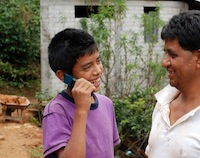 For many of us, it’s hard to imagine a world without mobile phones. Yet according to the global association that represents mobile operators (the GSMA), although nearly 80% of the population in Europe were mobile subscribers at the end of 2014, this figure drops to less than 40% for areas such as Sub-Saharan Africa. This is certainly something to consider the next time you leave your mobile at home, the battery dies, or you temporarily lose reception.
For many of us, it’s hard to imagine a world without mobile phones. Yet according to the global association that represents mobile operators (the GSMA), although nearly 80% of the population in Europe were mobile subscribers at the end of 2014, this figure drops to less than 40% for areas such as Sub-Saharan Africa. This is certainly something to consider the next time you leave your mobile at home, the battery dies, or you temporarily lose reception.
Of course, mobile communications are about much more than simply convenience; there are those times when a phone call may be a matter of life and death. Unfortunately, telecoms infrastructure is typically expensive, particularly when it comes to mobile network infrastructure. As such, operators may deem it not economically viable to provide services to less densely populated areas. This means that those who would arguably stand to benefit the most are often those who have to go without.
The mobile infrastructure marketplace is dominated by heavily proprietary platforms, which goes a long way toward explaining their cost. This situation is finally changing, however, and there are now no less than three open source GSM network implementations. The one most often heard of — having received media attention after being used to provide a temporary network at the Burning Man festival — is OpenBTS. In this article, however, I will take a look at the Osmocom (Open Source for MObile COMmunications) GSM stack, which has a slightly steeper learning curve, but offers certain benefits, such as greater flexibility.
From Hack to Comprehensive Stack
Osmocom is a familyofprojects that also includes implementations of systems such as DECT, as used by cordless phones, and TETRA, which is used by emergency services, rail, and utilities. GSM infrastructure software is developed under the OpenBSC project, with BSC being short for Base Station Controller. However, the software also can be configured to provide an entire, albeit simplified, network core, complete with subscriber database and authentication services.
The development of OpenBSC started out around the same time as OpenBTS, with both making their first releases in 2008. However, whereas the OpenBTS project set about creating a solution that would use generic software-defined radio (SDR) hardware, OpenBSC targeted surplus commercial base station (BTS) equipment, which could be driven over the GSM “A-bis” interface after reverse-engineering a particular vendor’s implementation of the standard.
Although OpenBTS provides a more monolithic solution that transitions as quickly as possible from the GSM air interface — “Um” — to VoIP, the Osmocom software is much more modular in nature and can be configured purely as a BSC and to fit within an existing GSM architecture, or as a complete network-in-a-box. This is not to say that OpenBSC can only be used with legacy networks; far from it. Just like OpenBTS, it can be integrated with modern VoIP networks via LinuxCallRouter and FreeSWITCH. It can also be used with SDR hardware thanks to OsmoTRX, a version of the OpenBTS transceiver module with various enhancements.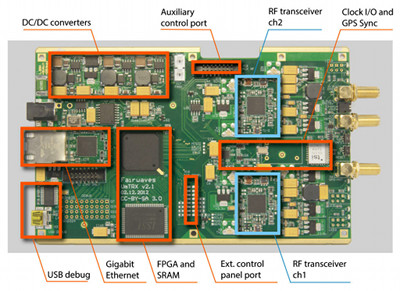
Additionally, OpenBSC is completely open source, developed by a global community with several organizations sponsoring development. One of these is sysmocom and another is Fairwaves, who created an open hardware transceiver that, together with Osmocom software, Linux, and ecosystem technologies, is being used to build turnkey solutions.
UmTRX and Linux at Heart
Fairwaves developed UmTRX, an open source hardware dual-channel transceiver designed specifically for use with cellular networks. This supports two fully independent radio channels, thereby doubling the call capacity. Additionally, it integrates a GPS receiver and has been tested against GSM specifications under extreme environmental conditions.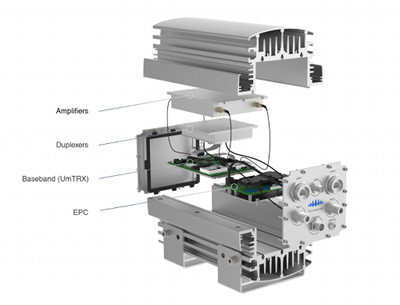
Turnkey base stations combine UmTRX with a commodity embedded PC, plus RF power amplifiers, LNAs, and duplexers selected for the required coverage and GSM band. This is all packaged in a protective enclosure, which allows the base station to be tower mounted and ensures that it will operate within the stated specifications come rain or shine.
While UmTRX bridges the RF and digital domains, Linux provides a robust and highly configurable platform for system software such as Osmocom and FreeSWITCH. Its soft real-time capabilities are perfect for GSM, with multi-core CPUs making it possible to run timing-sensitive low-level digital signal processing (DSP) alongside databases and web servers — all on the same host. Having a complete mobile network in a single box is something proprietary systems have struggled to do for many years. Now it is possible, thanks to the open source ecosystem and in a large part, Linux.
Because cell sites are frequently located in remote areas, reliability and remote management are vital. With this in mind, Ubuntu LTS releases are used and remote management is carried out via OpenVPN. Linux ecosystem software such as web servers, frameworks, and databases allowing additional value to be created and a technical solution to be transformed into a finished product (e.g., by exposing RESTful APIs).
Connecting Rural Villages
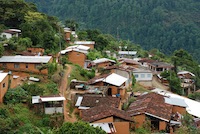 A fundamental driver for open source mobile infrastructure is to bring networks to places that have never had them. Santa Maria Yaviche, located deep in the mountains of Oaxaca, Mexico, with a community of around 700 inhabitants and about 3 hours drive from the nearest location with any coverage, is one such place.
A fundamental driver for open source mobile infrastructure is to bring networks to places that have never had them. Santa Maria Yaviche, located deep in the mountains of Oaxaca, Mexico, with a community of around 700 inhabitants and about 3 hours drive from the nearest location with any coverage, is one such place.
In late 2013, thanks to an experimental Mexican government concession allowing Rhizomatica to install mobile networks in indigenous communities, Fairwaves worked with them to install a base station in the village. This started out as a fairly DIY affair with two patch antennas fastened to a 6m bamboo pole, that was in turn secured to the rooftop of a two-story building. It was easily possible to cover the entire village with only a 2-watt RF amplifier used with each channel. Having quickly proved its importance, the network was subsequently upgraded with a proper mast and fully integrated UmSITE base station.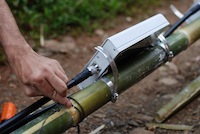
From there, the numbers speak for themselves, with the network immediately detecting more than 100 mobiles, and 2 weeks later having more than 400 registered. The network quickly went on to connect 500-1,000 local calls and deliver 3,000-4,000 text messages in a typical day.
Since then Fairwaves has had open source-powered base stations installed on every continent apart from Antarctica. They have, for example, been used to provide a private GSM network at one the Netherlands largest festivals, the Walk of the World, covering the city of Nijmegen during the event and ensuring high network availability, independent of the incumbent operators.

Flexibility and the Future
Not only do open source solutions mean reduced cost, they also are typically easier to adapt to other uses. This is particularly true where a modular approach is taken and solutions are made up of numerous smaller components that can be reconfigured to support new use cases. This inherent flexibility, together with a lower barrier to entry, promises to take open source cellular infrastructure to places where proprietary counterparts simply cannot go, whether that’s a remote village, a private network, or some as yet unexplored — or previously cost prohibitive — use.
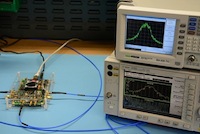 One recent modification that Fairwaves were able to make to the Osmocom software meant that a singleUmTRXtransceivercouldbeusedtosupporttwofullyindependentbasestations, or even two completely different mobile networks for that matter.
One recent modification that Fairwaves were able to make to the Osmocom software meant that a singleUmTRXtransceivercouldbeusedtosupporttwofullyindependentbasestations, or even two completely different mobile networks for that matter.
Getting Hands-On
UmTRX boards are available for lab use and in DIY projects, and the Osmocom software also supports several generic SDR platforms (although an external clock source may be required).
Given their very nature, SDR applications tend to be relatively computationally intensive. However, single board computers continue to become more powerful and even a quad-core RaspberryPi 2ModelBiscapable of running up the full Osmocom stack for GSM voice and SMS services.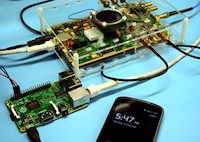
Transmitting on GSM spectrum typically requires a license and doing so without one would, in most cases, land you in trouble. However, wireless regulators are typically able to license spectrum for test and development purposes, albeit with certain limitations. It’s also possible to buy or construct small test chambers that prevent signals from escaping and causing interference.
Calling Policy Hackers!
Since Fairwaves and Rhizomatica installed a mobile network in Yaviche, there has been a change in the regulatory landscape, with the Mexican wireless regulator allocating specific bands for the provision of rural connectivity. However, there is a great deal more work to be done and policy hackers are much needed. Access to technology is part of the problem, but access to spectrum is equally important in making universal mobile coverage a reality.
Prime chunks of spectrum have been reserved as “guard bands” or “white spaces,” left unused to prevent interference between adjacent bands or channels. However, advances in wireless technologies and techniques have made this practice unnecessary. Real-time geolocation databases can now be used to provide efficient, coordinated access, while modern wireless systems are able to identify and give way to priority spectrum users. Both of these technologies enable a dynamic approach to spectrum management, whereby large swathes of an immensely valuable resource need not be left unused.
DECT handsets operate at around 1800-1900MHz, close by to GSM bands and with, historically, guard bands situated in between. The Netherlands has taken an enlightened approach to the reuse of this prime spectrum and made it available for unlicensed use, enabling private networks to be set up. Unfortunately, it’s more typical for such spectrum “dividends” to be licensed to one or a small number of users, and pressure needs to be put on regulators to follow the Dutch example.
A New Chapter in Mobile Communications
It’s an immensely exciting time for mobile communications as open source 2G technology matures and starts to make inroads, while multiple 4G implementations are under active development. This is perhaps one of the few areas in tech that has thus far not enjoyed the many and substantial benefits that open source brings. But, all that is set to change.
Adoption of open source mobile technology will likely continue in lower income and remote areas, where proprietary solutions are simply not economically viable. This is vitally important as a large section of the global population remains without access to mobile communications.
However, over time it would seem reasonable to expect much more widespread adoption. After all, network operators could stand to make huge savings by switching, while freeing them up to focus on the development of services that provide market differentiation. Further pressure will come via 4G and beyond, with the need for a far greater number of smaller cells and increased ability to innovate at the edges, free from proprietary technology constraints.
Andrew Back is community manager for the UmTRX project.


